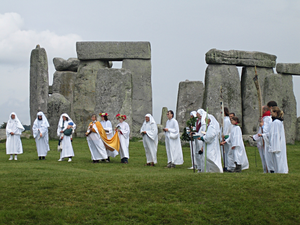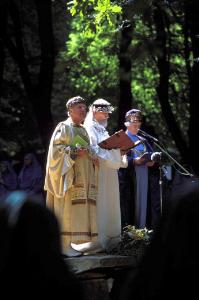
Back Neodruidismo AN Drouizelezh Breton Neodruïdisme Catalan Neodruidismus Czech Neuzeitliche Druiden German Druidismo Esperanto Neodruidismo Spanish Druidism Estonian دروئید (امروزی) Persian Druidismi Finnish


Druidry, sometimes termed Druidism, is a modern spiritual or religious movement that promotes the cultivation of honorable relationships with the physical landscapes, flora, fauna, and diverse peoples of the world, as well as with nature deities, and spirits of nature and place.[1] Theological beliefs among modern Druids are diverse; however, all modern Druids venerate the divine essence of nature.[2]
While there are significant variations in the expression and practice of modern Druidry, a core set of spiritual and devotional practices may be observed, including: meditation; prayer/conversation with deities and spirits; the use of extra-sensory methods of seeking wisdom and guidance; the use of nature-based spiritual frameworks to structure devotional practices and rituals; and a regular practice of nature connection and environmental stewardship work.[3]
Arising from the 18th century Romanticist movement in Britain, which glorified the ancient Celtic peoples of the Iron Age, the early neo-Druids aimed to imitate the Iron Age priests who were also known as druids. At the time, little accurate information was known about these ancient priests, and the modern Druidic movement has no direct connection to them, despite contrary claims made by some modern Druids.[4]
In the late 18th century, modern Druids developed fraternal organizations modeled on Freemasonry that employed the romantic figure of the British Druids and Bards as symbols of the indigenous spirituality of Prehistoric Britain. Some of these groups were purely fraternal and cultural, such as the oldest one that remains, the Ancient Order of Druids founded in 1781, creating traditions from the national imagination of Britain. Others, in the early 20th century, merged with contemporary movements such as the physical culture movement and naturism. Since the 1980s, some modern druid groups have adopted similar methodologies to those of Celtic Reconstructionist Paganism in an effort to create a more historically accurate practice. However, there is still controversy over how much resemblance modern Druidism may or may not have to the Iron Age druids.
By 2020, modern Druidry had spread to 34 nations, across 6 continents,[5] and had taken root in 17 diverse biomes.[6] The importance that modern Druids attributed to Celtic language and culture, circa 2020, varied depending upon the physical and cultural environments in which the individual Druid lived.[7] By 2020, roughly 92% of world Druids were living outside the British Isles.[8]
Based on 2011–2013 census data from Britain, Canada, Australia, New Zealand, and Ireland, and 2008 ARIS Report data from the United States, the population of Druids residing in anglophone nations was estimated at 59,299.[8] The current global population of Druids is likely to significantly exceed this number, as many countries with resident Druids do not allow for the existence of Druidry within their census instruments.[9] Pagan faith surveys are also likely to undercount Druids, as only 63% of world Druids identify with either of the categories Pagan or Heathen.[10] In addition, 74% of world Druids report having significant privacy and safety concerns, due to discrimination and persecution within their local communities, and so are likely to be underreported in the census data that does exist.[11]
While modern Druidry has spread rapidly across the globe, Druids do not proselytize,[12] and 74% of world Druids actively work to keep their spiritual practices private.[13]
- ^ White 2021, p. 253-255.
- ^ White 2021, p. 113-157,254.
- ^ White 2021, p. 186-187.
- ^ "The Druids". The British Museum. Archived from the original on 23 December 2012. Retrieved 1 December 2014.
Modern Druids have no direct connection to the Druids of the Iron Age. Many of our popular ideas about the Druids are based on the misunderstandings and misconceptions of scholars 200 years ago. These ideas have been superseded by later study and discoveries.
- ^ White 2021, p. 16-17.
- ^ White 2021, p. 25-26.
- ^ White 2021, p. 27-28.
- ^ a b White 2021, p. 280-283.
- ^ White 2021, p. 279-280.
- ^ White 2021, p. 114.
- ^ White 2021, p. 31.
- ^ Doyle White 2016, p. 360.
- ^ White 2021, p. 29-58.